ABACABA pattern
The ABACABA pattern is a recursive fractal pattern that shows up in many places in the real world (such as in geometry, art, music, poetry, number systems, literature and higher dimensions).[1][2][3][4] Patterns often show a DABACABA type subset.
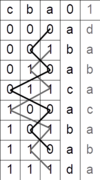
DABACABA patterns in (3-bit) binary numbers
Generating the pattern
In order to generate the next sequence, first take the previous pattern, add the next letter from the alphabet, and then repeat the previous pattern. The first few steps are listed here.[4] A generator can be found here
| Step | Pattern |
|---|---|
| 1 | A |
| 2 | ABA |
| 3 | ABACABA |
| 4 | ABACABADABACABA |
| 5 | ABACABADABACABAEABACABADABACABA |
| 6 | ABACABADABACABAEABACABADABACABAFABACABADABACABAEABACABADABACABA |
Gallery
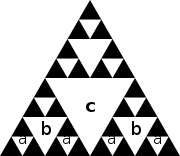 Sierpinski triangle:
Sierpinski triangle:
ABACABA 
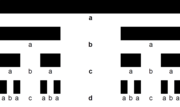
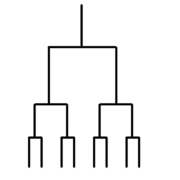
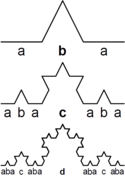 Koch curve: is ABA, is ABACABA, and : ABACABADABACABA
Koch curve: is ABA, is ABACABA, and : ABACABADABACABA Metric hierarchy:
Metric hierarchy:
ABACABADABACABA[lower-alpha 1] 
 A staircase built with the largest possible squares/cubes while allowing equally sized steps:
A staircase built with the largest possible squares/cubes while allowing equally sized steps:ABACABADABACABA[1] 
gollark: Different parts of it will be simulated at different times, but that's not detectable since the simulation of it outputs the same stuff.
gollark: * designed to be
gollark: Or, to avoid any weird brain weirdness, a dual-core computer or something, which we know are designed to deterministic.
gollark: Assuming no weirdness, if you run a highly advanced physics simulator on a Turing machine and load in a brain, said brain will "multitask".
gollark: Multitasking isn't relevant to what it can compute.
See also
Notes
- The strength, emphasis, or importance of the beginning of each duration the length of a single measure in 4/4 (eighth-notes) is, divisively (, , ), determined by each eighth-note's position in a DABACABA structure, while the eighth notes of two measures grouped, additively (), are determined by an EABACABADABACABA structure.[3]
References
- Naylor, Mike (February 2013). "ABACABA Amazing Pattern, Amazing Connections". Math Horizons. Retrieved June 13, 2019.
- SheriOZ (2016-04-21). "Exploring Fractals with ABACABA". Chicago Geek Guy. Retrieved 2017-10-06.
- Naylor, Mike (2011). "Abacaba! – Using a mathematical pattern to connect art, music, poetry and literature" (PDF). Bridges. Retrieved October 6, 2017.
- Conley, Craig (2008-10-01). Magic Words: A Dictionary. Weiser Books. p. 53. ISBN 9781609250508.
External links
- Naylor, Mike: abacaba.org
This article is issued from Wikipedia. The text is licensed under Creative Commons - Attribution - Sharealike. Additional terms may apply for the media files.